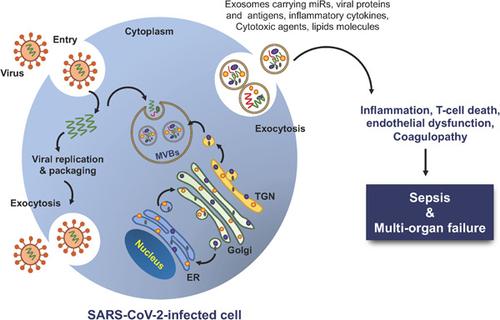当前位置:
X-MOL 学术
›
J. Cell. Physiol.
›
论文详情
Our official English website, www.x-mol.net, welcomes your
feedback! (Note: you will need to create a separate account there.)
Mechanisms of COVID‐19‐induced cardiovascular disease: Is sepsis or exosome the missing link?
Journal of Cellular Physiology ( IF 4.5 ) Pub Date : 2020-10-20 , DOI: 10.1002/jcp.30109 Mallikarjun Patil 1 , Sarojini Singh 1 , John Henderson 1 , Prasanna Krishnamurthy 1
Journal of Cellular Physiology ( IF 4.5 ) Pub Date : 2020-10-20 , DOI: 10.1002/jcp.30109 Mallikarjun Patil 1 , Sarojini Singh 1 , John Henderson 1 , Prasanna Krishnamurthy 1
Affiliation

|
Coronavirus disease 2019 (COVID‐19), caused by the severe acute respiratory syndrome coronavirus 2 (SARS‐CoV‐2), has reached a pandemic level, spreading across the globe by affecting over 33 million people and causing over 1,009,270 deaths. SARS‐CoV‐2 is highly infectious with a high basic reproduction number (R0) of 2.2–5.7 that has led to its exponential spread. Besides, very little is known about it in terms of immunogenicity and its molecular targets. SARS‐CoV‐2 causes acute respiratory distress syndrome, followed by multiple organ failure and death in a small percentage of individuals. Cardiac injury has emerged as another dreaded outcome of COVID‐19 complications. However, a thorough understanding of the pathogenesis of SARS‐CoV‐2 is lacking. In this review, we discuss the virus, possible mechanisms of COVID‐19‐induced cardiac injury, and potential therapeutic strategies, and we explore if exosomes could be targeted to treat symptoms of COVID‐19. Furthermore, we discussed the virus‐induced sepsis, which may be the cause of multiple organ failure, including myocardial injury.
中文翻译:

COVID-19 诱发心血管疾病的机制:败血症或外泌体是缺失的环节吗?
由严重急性呼吸综合征冠状病毒 2 (SARS-CoV-2) 引起的 2019 冠状病毒病 (COVID-19) 已达到大流行水平,在全球范围内蔓延,影响了超过 3,300 万人,并导致超过 1,009,270 人死亡。SARS-CoV-2 具有高度传染性,其基本传染数 ( R 0 ) 高达 2.2-5.7,导致其呈指数级传播。此外,人们对其免疫原性及其分子靶点知之甚少。SARS-CoV-2 会导致急性呼吸窘迫综合征,随后导致一小部分人出现多器官衰竭和死亡。心脏损伤已成为 COVID-19 并发症的另一个可怕后果。然而,人们对 SARS-CoV-2 的发病机制缺乏透彻的了解。在这篇综述中,我们讨论了病毒、COVID-19 引起的心脏损伤的可能机制以及潜在的治疗策略,并探讨了外泌体是否可以靶向治疗 COVID-19 的症状。此外,我们讨论了病毒引起的败血症,这可能是多器官衰竭的原因,包括心肌损伤。
更新日期:2020-10-20
中文翻译:

COVID-19 诱发心血管疾病的机制:败血症或外泌体是缺失的环节吗?
由严重急性呼吸综合征冠状病毒 2 (SARS-CoV-2) 引起的 2019 冠状病毒病 (COVID-19) 已达到大流行水平,在全球范围内蔓延,影响了超过 3,300 万人,并导致超过 1,009,270 人死亡。SARS-CoV-2 具有高度传染性,其基本传染数 ( R 0 ) 高达 2.2-5.7,导致其呈指数级传播。此外,人们对其免疫原性及其分子靶点知之甚少。SARS-CoV-2 会导致急性呼吸窘迫综合征,随后导致一小部分人出现多器官衰竭和死亡。心脏损伤已成为 COVID-19 并发症的另一个可怕后果。然而,人们对 SARS-CoV-2 的发病机制缺乏透彻的了解。在这篇综述中,我们讨论了病毒、COVID-19 引起的心脏损伤的可能机制以及潜在的治疗策略,并探讨了外泌体是否可以靶向治疗 COVID-19 的症状。此外,我们讨论了病毒引起的败血症,这可能是多器官衰竭的原因,包括心肌损伤。











































 京公网安备 11010802027423号
京公网安备 11010802027423号